#both parents have lore if that sort of thing floats your boat
Explore tagged Tumblr posts
Text



Happy FR anniversary! My progens (who have been around for 11 years now) have had a nest. Both hatchlings are only 25kt on the AH.
#flight rising#flight rising sales#dragon sales#both parents have lore if that sort of thing floats your boat#boosts are appreciated#i would really like these two to find homes
7 notes
·
View notes
Text
Katabasis Patterns in Pirates of the Caribbean: At World’s End
Or, in which I make use of my official Classics minor (and my unofficial film nerd minor) while ignoring my French major altogether.
Howdy, everyone, and welcome to this week’s episode of Extremely On My Bullshit! Today we’re going to talk at length about how the trip to Davy Jones’ Locker in Pirates of the Caribbean: At World’s End borrows elements from various classical narratives containing a katabasis, or a trip to the Underworld. This will be a slightly Tumblr-ified version of an actual paper I wrote for my Classical Antiquity On Screen final.
Shoutout to this post by @charlesdances, which allowed me to infodump about Hades/Persephone parallels in Barbossa and Elizabeth’s relationship across the trilogy, and to @aye-tortuga for requesting this longer post, which I teased at the end of the aforementioned meta.
Right then, let’s get started! Under a cut to spare your dashes from long post made longer still by screencaps and works cited (yep, it’s that kind of meta). For the purposes of this meta, only the first three Pirates films will be considered canon as the later sequels contradicted elements of the established lore.
I touched on this in the first paragraph, but I’ll begin by defining two words which will appear throughout this meta: katabasis and anabasis. Katabasis and anabasis are Ancient Greek terms which refer to “that narrative . . . that portrays the hero’s descent into, and ascent from, the underworld—the journey to hell” (Holtsmark 25). (If you want to get etymological about it, kata is down, ana is up, and baino comes from the verb meaning “to go [on foot].”)
This katabasis narrative takes place in the first act of At World’s End. If you’ll recall, Dead Man’s Chest ended with Elizabeth chaining Jack to the Black Pearl’s mast: she knew the Kraken was only interested in Jack, so she sacrificed him to give herself and the others a chance to escape. However, at the very end of the film, Elizabeth and the crew of the Pearl pledge to retrieve Jack from his resting place in Davy Jones’ Locker (the Underworld), and Tia Dalma offers both herself and Barbossa as guides to those “weird and haunted shores.”
So, after the cinematic fucking masterpiece that is the opening “Hoist the Colours” sequence (I also wrote a paper on that lol), we find ourselves in Singapore, where Elizabeth, Barbossa, and co. meet with the pirate lord Sao Feng in hopes of obtaining a map to the Locker. The Singapore segment opens with Elizabeth piloting a lone craft along a murky river, evoking images of Charon with his ferryman’s pole:
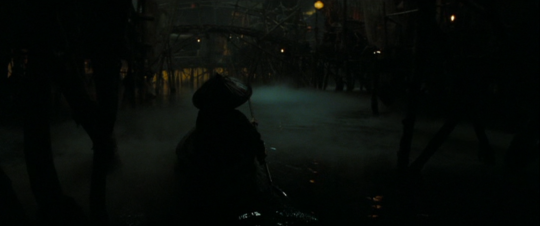

As she poles the boat along, she sings a pirate tune with decidedly death-centric lyrics, tuning us in to the symbolism and themes at play: “Some men have died and some are alive / Others sail on the sea / With the keys to the cage and the Devil to pay / We lay to Fiddler’s Green.* / The bell has been raised from its watery grave / Hear its sepulchral tone . . .” (*A form of afterlife from maritime folklore)
At the end of this scene, we see something odd: Tia Dalma dressed as a blind organ grinder.

Plot-wise, this serves to divert the colonial soldiers’ attention from the pirates’ activity, but metaphorically, here she represents the blind seer Tiresias, whom Odysseus encounters when he first enters the realm of Hades (Odyssey 11.187-149).
When the pirates meet Sao Feng, the imagery starts to mix a little. The filmmakers present Sao Feng in a somewhat Hades-esque (Hadean?) manner (steam, flames, and warm tones, with a skylight to imply subterranean depths):
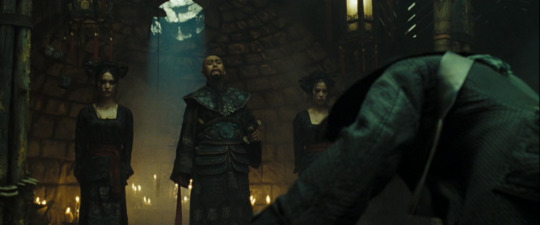
However, while he is a powerful figure, he does not keep the Underworld itself (that duty falls to Jones); he merely keeps the knowledge of its entrance. Barbossa attempts to gain this knowledge by presenting Sao Feng with a silver coin: a reminder of his duty as Pirate Lord as well as another Charon parallel. Barbossa’s tactic does not work, but like in the previous scene, the imagery prepares viewers for the descent to come.
After getting Sao Feng’s navigational charts another way, the pirates’ journey to the underworld continues in earnest. When Will expresses doubt about their path, Barbossa nearly quotes the Aeneid outright: “Trust me, young Master Turner: it’s not gettin’ to the Land of the Dead that’s the problem; it’s gettin’ back.” This echoes the Cumaean Sibyl’s famous words to Aeneas: “Easy is the descent to [the Underworld]: night and day the door of gloomy Dis stands open; but to recall one’s steps and pass out to the upper air, this is the task, this the toil!” (Aeneid 6.126-129, tr. H.R. Fairclough). Aeneas, guided by the Sibyl, passes through the mouth of a cave as part of his descent (“A deep cave there was, yawning wide and vast, of jagged rock” (Aeneid 6.237-238, cf. 6.262-263, tr. Fairclough)); likewise the pirates, guided by Barbossa and the charts, pass through a cave as they travel into stranger climes:
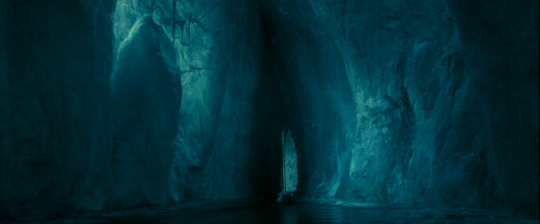
(Buuuut to be fair, this one is possibly just incidental or else more of a reference to Gustave Doré’s art for Rime of the Ancient Mariner rather than a reference to any specific classical text. Doré’s artwork is used elsewhere in PotC, so it’s prolly just aesthetic. Also caves are cool and the ultimate symbolic doorway.)
Next they come to a distant, shadowy realm with a misty sky and a sea tranquil enough to reflect starlight:
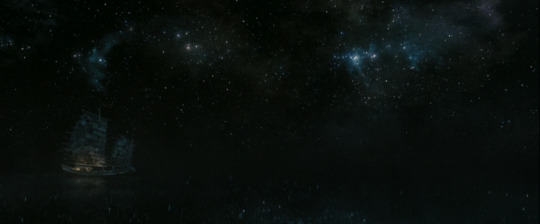

Again, this could also be incidental (and/or just a really cool homage to the sailing-to-the-moon scene in The Adventures of Baron Munchausen (1988)), but it does have a classical counterpart: “The ship took us to the deep, outermost Ocean / And the land of the Cimmerians, a people / Shrouded in mist. The sun never shines there [...] Nor bathes them in the glow of its last golden rays; / Their wretched sky is always racked with night’s gloom” (Odyssey 11.14-19).
Both of these qualities—the cave and the darkness—fit Holtsmark’s observations on katabatic patterns: “The entryway to the other world is often conceived as lying in caves or grottoes or other openings in the earth’s crust into the nether regions, such as chasms or clefts. . . . The lower world is generally dank and dark, and the journey usually takes place at dusk or during the night” (Holtsmark 25).
At last, the pirates’ ship goes over the edge of an enormous waterfall and the screen fades to black. Voices from the original Pirates of the Caribbean theme park ride echo over the dark screen, ending with the ominous phrase “Dead men tell no tales.” However, we shall soon see this proved very wrong, for the pirates encounter several souls with tales to tell. As for these nameless voices, they may represent multitudes of “bloodless shades” (Metamorphoses 10.42) left to languish in other parts of the Locker/Underworld.
At this point, the narrative cuts from the pirate band to Jack in Davy Jones’ Locker. Jack warrants special punishment from Jones for disobeying the rules of a bargain they’d once struck (*yells forever about the good parts of The Price of Freedom and the crimes wrought by the DMTNT retcons*). Jack’s own special hell, recalling the punishments of Tantalus and Sisyphus (Odyssey 11.611-629), does include his beloved Black Pearl (explicitly stated, by Jack himself, to be a symbol of personal freedom), but now it rests completely beached upon an endless, windless salt flat. Jack is utterly alone in this wasteland, save for a crew of his own imaginary doppelgängers.
(I’m gonna be real with y’all: I don’t care for this scene at all and it brings the narrative to a screeching halt, so let’s just take a moment to angstily reflect on how profoundly this affects Jack-the-character’s psyche/mental state for the rest of the film and move on to better things. God bless RPers and fic writers who deal with this scene and its effects in a deliciously Watsonian way.)
Tia Dalma/Calypso’s crabs eventually come to bear both captain and ship back to the sea. This could be seen as classical-type divine aid/favoritism (a semi-literal deus ex machina) or as awkward, oh-no-what-do-we-do-now screenwriting, take your pick. The crabs take Jack and the Pearl directly to the rest of the pirates, who have washed up on the Locker’s desolate shore. In a twist on the classical formula, Jack initially thinks his rescuers the dead ones as they recount their past experiences. Additionally, Jack represents a sort of Eurydice figure as the dead-in-need-of-rescuing, while his Orpheus, Elizabeth, is ironically the one who “killed” him in the first place. All the pirates (Jack included) finally set sail in the freed Black Pearl and attempt to escape this Underworld: the anabasis has begun.
On their way out, when the sky grows dark, the crew encounter scores upon scores of shades floating aimlessly upon the sea:
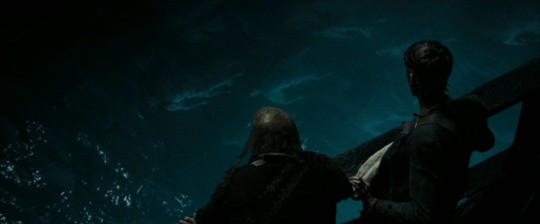
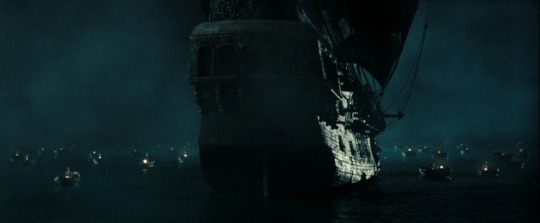
This parallels Odysseus’ experience (“Then out of Erebus / The souls of the dead gathered / . . . They drifted up to the pit from all sides / With an eerie cry, and pale fear seized me” (Odyssey 11.34-35, 40-41)) as well as that of Aeneas (“Hither rushed all the [ghostly] throng, streaming to the banks . . . They stood, pleading to be the first ferried across, and stretched out hands in yearning for the farther shore” (Aeneid 6.305, 313-314)). Tia Dalma reveals that long ago, Calypso had charged Davy Jones “to ferry those who died at sea to the Other Side,” but he has since abandoned his duty, hence his current eldritch appearance. This explicitly posits Jones as a failed psychopomp who has now left these souls stranded like the unburied men of the Odyssey and Aeneid.
The crew leave these shades in peace until Elizabeth spots a familiar face: her father.
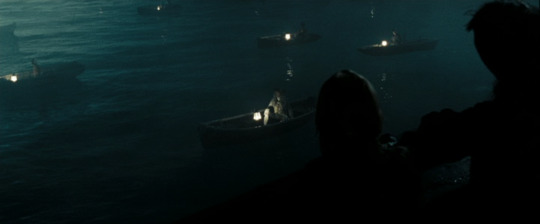

At this point I must ask you to rewatch this scene so you can fully appreciate the parallels without me including a lengthy transcript in this already long post.
This scene comes directly from classical literature, as both Odysseus and Aeneas encountered dead parents in the Underworld. Odysseus saw his mother: “. . . At once / She knew me, and her words reached me on wings: / ‘My child, how did you come to the undergloom / While you are still alive? It is hard for the living / To reach these shores. There are many rivers to cross, / Great bodies of water, nightmarish streams, / And Ocean itself, which cannot be crossed on foot / But only in a well-built ship’” (Odyssey 11.151-158). Like Elizabeth, Odysseus had no prior knowledge of his mother’s passing (11.170). His mother warned him of the dangerous situation which had sprung up during his absence, just as Weatherby Swann warned the pirates of the dangers of Davy Jones’ Heart. Aeneas likewise encountered the spirit of his father, Anchises: “‘Have you come at last[?] . . . Over what lands, what wide seas have you journeyed to my welcome! What dangers have beset you, my son!’” (Aeneid 6.687-693). Anchises, too, offers some advice for the future, for he “tells of the wars that the hero next must wage . . . [and] how to face or flee each peril” (6.890-892). Having Elizabeth be the one to encounter a dead parent in the Underworld confirms her as the series’ protagonist, in case that wasn’t patently obvious from the rest of the trilogy (and the failure of Pirates 4 and 5). Weatherby Swann’s warning also serves to remind the audience of the stakes.
Finally, the pirates make their way out of the Locker. While the remainder of their journey takes more inspiration from Rime of the Ancient Mariner and Western European folklore than classical literature, the latter’s influence on the film remains quite clear. When the pirates return to the land of the living, it is daybreak:

(*Lawrence of Arabia theme, but on a cello*)
So, too, does Odysseus emerge from the Underworld into a new dawn: “Our ship left the River Ocean / And came to the swell of the open sea / . . . Where Dawn has her dancing grounds / And the Sun his risings” (Odyssey 12.1-5). The pirates thus complete their katabasis/anabasis, and with rather more luck than Orpheus.
In review: The pirates begin their katabasis in Singapore, which boasts a plethora of Underworld symbolism, including a death-centric song and images of Charon, Tiresias, and Hades. They cross various waters in their descent, mirroring locations from Homer and Vergil, and Barbossa quotes the Cumaean Sibyl. Elizabeth and the pirates retrieve Jack from the Locker’s punishments in a twist on the Orpheus and Eurydice myth. Like Odysseus and Aeneas, Elizabeth sees her dead parent in the Underworld, who warns her of things to come. In the end, the pirates emerge from the Underworld into the light of dawn, signalling their return to life. By borrowing from Homer, Vergil, and Ovid, At World’s End presents an Underworld narrative which is familiar in structure and yet easily incorporated into a new mythology: “Same story, different versions.”
(Please message me if you’d like to quote/reference this post in a paper and I can give you my name + details on the official version! Plagiarism is shitty and unnecessary!)
WORKS CITED
Crispin, A.C. Pirates of the Caribbean: The Price of Freedom. Disney Editions, 2011.
Fairclough, H.R., translator. The Aeneid. 1916. By Vergil. Theoi Project, www.theoi.com/Text/VirgilAeneid6.html. Accessed 4 May 2019.
Holtsmark, Erling B. “The Katabasis Theme in Modern Cinema.” Classical Myth & Culture in Modern Cinema, edited by Martin M. Winkler, Oxford University Press, 2001, pp. 23-50.
Homer. The Odyssey. The Essential Homer, translated and edited by Stanley Lombardo, Hackett Publishing Company, 2000, pp. 241-482.
Ovid. Metamorphoses. Translated by Stanley Lombardo, Hackett Publishing Company, 2010.
Pirates of the Caribbean: At World’s End. Directed by Gore Verbinski, performances by Keira Knightley, Johnny Depp, Orlando Bloom, Bill Nighy, Chow Yun-Fat, Geoffrey Rush, Tom Hollander, Jack Davenport, and Jonathan Pryce, Walt Disney Pictures, 2007.
Pirates of the Caribbean: Dead Man’s Chest. Directed by Gore Verbinski, performances by Keira Knightley, Johnny Depp, Orlando Bloom, Bill Nighy, Tom Hollander, Jack Davenport, and Jonathan Pryce, Walt Disney Pictures, 2005.
Pirates of the Caribbean: The Curse of the Black Pearl. Directed by Gore Verbinski, performances by Keira Knightley, Johnny Depp, Orlando Bloom, Geoffrey Rush, Jack Davenport, and Jonathan Pryce, Walt Disney Pictures, 2003.
#dear god i hope this posts#pirates of the caribbean#potc#tagamemnon#meta#classics#long post#loooooooong post#katabasis#my meta#if you steal this i will physically manifest in your home and hand you the black spot
286 notes
·
View notes